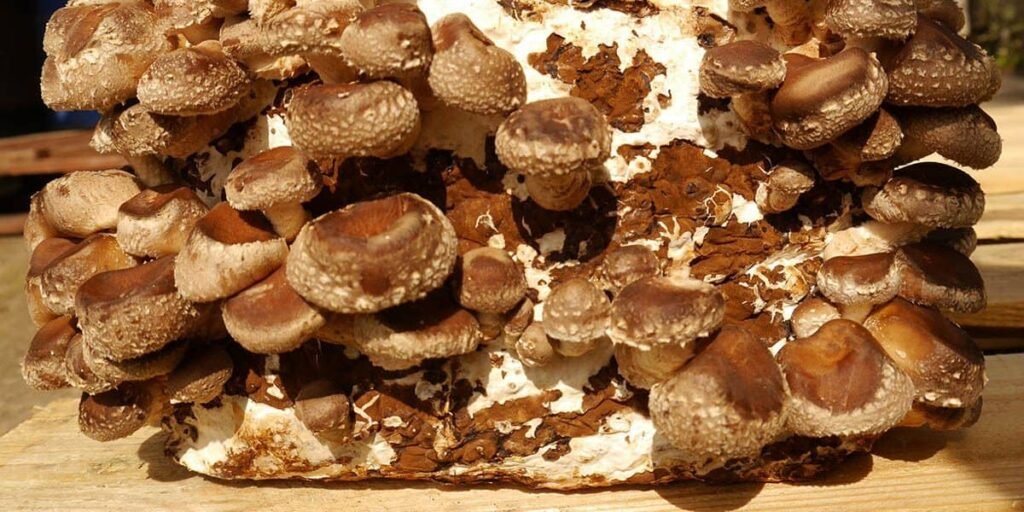Shiitake mushrooms, known for their rich, earthy flavor and numerous health benefits, have become increasingly popular among chefs, home cooks, and health enthusiasts. As the demand for these gourmet mushrooms continues to rise, shiitake mushroom farming presents a unique opportunity for farmers and entrepreneurs looking to diversify their agricultural ventures. This blog explores the process of shiitake mushroom farming, its benefits, and why it can be a sustainable and profitable business.
What Are Shiitake Mushrooms?

Shiitake mushrooms (Lentinula edodes) are native to East Asia and have been cultivated for thousands of years, particularly in Japan and China. They are renowned for their umami flavor, making them a prized ingredient in various cuisines. Beyond their culinary uses, shiitake mushrooms are also valued for their medicinal properties, including boosting the immune system, reducing inflammation, and even fighting cancer cells.
The Process of Shiitake Mushroom Farming
Shiitake mushrooms are typically grown on hardwood logs, such as oak, maple, or beech, or on sawdust blocks. The process of cultivating shiitake mushrooms involves several key steps:
- Log or Substrate Preparation: If using logs, they must be freshly cut and free of contaminants. The logs are then drilled with small holes where shiitake spawn (mycelium) will be inserted. If using sawdust blocks, the blocks are sterilized and inoculated with the spawn.
- Inoculation: The shiitake spawn is introduced into the prepared logs or blocks. For logs, the spawn is placed into the drilled holes and sealed with wax to prevent contamination. The logs are then stacked in a shaded area where they can rest and allow the mycelium to colonize the wood. This process can take several months.
- Incubation: The inoculated logs or blocks are stored in a controlled environment with high humidity and consistent temperatures. During this incubation period, the mycelium spreads throughout the log or substrate, breaking down the wood and preparing it for fruiting.
- Fruiting: Once the logs or blocks are fully colonized, they are soaked in water to stimulate the fruiting process. Within a few weeks, shiitake mushrooms will begin to emerge. The mushrooms are harvested when the caps are fully opened but before they flatten out completely.
- Harvesting and Storage: Shiitake mushrooms are typically harvested by hand, ensuring they are handled with care to avoid bruising. Fresh shiitake mushrooms can be stored in a cool, dry place for up to two weeks. They can also be dried for long-term storage, which intensifies their flavor and extends their shelf life.
Benefits of Shiitake Mushroom Farming
Shiitake mushroom farming offers a range of benefits, both for the farmer and the environment:
- High Market Demand: Shiitake mushrooms are highly sought after in gourmet kitchens, health food stores, and by consumers looking for nutritious, plant-based ingredients. Their unique flavor and health benefits make them a premium product that commands a higher price than many other types of mushrooms.
- Low Environmental Impact: Shiitake mushroom farming is a sustainable practice. The mushrooms grow on wood that would otherwise be discarded, such as fallen trees or pruned branches. This reduces waste and encourages the recycling of natural resources. Additionally, shiitake mushrooms require minimal water and land compared to traditional crops, making them an eco-friendly choice.
- Health Benefits: Shiitake mushrooms are a powerhouse of nutrients. They are rich in vitamins B and D, essential minerals like copper and selenium, and contain compounds that have been shown to boost the immune system, lower cholesterol, and even possess anti-cancer properties. By growing shiitake mushrooms, farmers are contributing to the health and well-being of their customers.
- Income Diversification: For farmers looking to diversify their income streams, shiitake mushroom farming can be a lucrative addition. The initial investment in logs or sawdust blocks, spawn, and equipment is relatively low, and once established, a shiitake mushroom farm can produce for several years with minimal ongoing costs. Moreover, the high value of shiitake mushrooms means that even small-scale operations can be profitable.
- Flexible Farming: Shiitake mushrooms can be grown in various environments, from small backyard farms to large commercial operations. They require little space and can be cultivated indoors or outdoors, making them an accessible venture for both urban and rural farmers.
Conclusion
Shiitake mushroom farming is more than just a profitable business; it’s a sustainable practice that benefits the environment, promotes health, and supports local economies. With the growing demand for high-quality, nutritious food, shiitake mushrooms are a valuable crop that can offer farmers a steady income and a way to contribute to the global movement towards sustainable agriculture. Whether you’re a seasoned farmer or a budding entrepreneur, shiitake mushroom farming is an opportunity worth exploring.
- किसानों के लिए आधुनिक कृषि यंत्रों का डिजिटल बाजार : Agroranto farm equipment rental business
- How to Start a Fruit Salad Business in the USA
- gopal credit card 1 lakh loan yojna 2025, गाय-भैंस पालकों के लिए खुशखबरी: अब मिलेगा ₹1 लाख तक का ब्याजमुक्त लोन
- हरियाणा पीएम कुसुम योजना 75% सब्सिडी पर सोलर पंप लगवाने का सुनहरा मौका | आवेदन करें 21 अप्रैल 2025 तक
- हरी खाद योजना 2025: मूंग और ढैंचा बीज पर 80% तक सब्सिडी पाएँ | dhaincha seeds subsidy in haryana.
Pingback: खेती के कामों में कृषि ड्रोन का उपयोग करें। समय और पैसों का बचत होगा।50 litre agriculture spraying drone price - agroranto